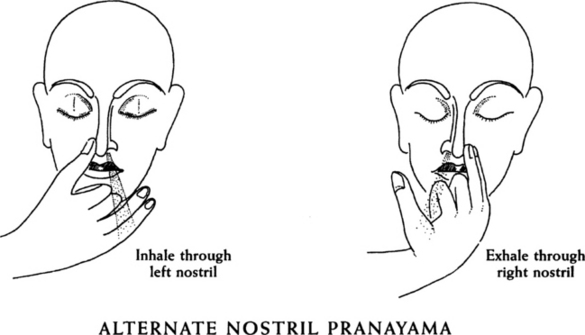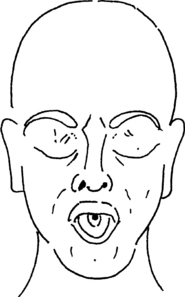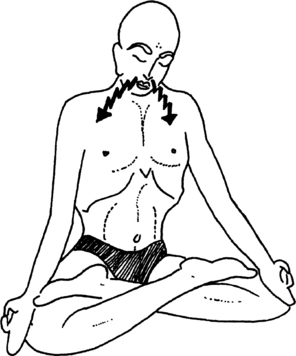
Prana is the bridge between body, mind, and consciousness. It is the constant movement of awareness. Prana carries awareness to the object of our perception; that movement of awareness through prana is called attention. The internal movement of prana is the movement of sensation, thought, feeling, and emotion. Thus prana and mind are deeply connected.
The physical manifestation of prana is breath. Breathing and mind are closely connected. Ayurveda says that breathing is the physical part of thinking and thinking is the psychological part of breathing. Every thought changes the rhythm of breath, and every breath changes the rhythm of thinking. When one is happy, blissful, and silent, breathing is rhythmic. If one is disturbed with anxiety, fear, or nervousness, the breathing is irregular and interrupted.
Ancient Vedic seers (rishis) discovered this intimate relationship between breathing and mental activity and uncovered the art of pranayama. Pranayama equals prana plus ayam. Ayam means “to control,” prana is “breath.” By controlling the breath, we can control mental activity.
The rishis also found an intimate relationship between the right and the left breath cycle. You may have noticed that sometimes you breathe more easily through the left nostril, and sometimes your breathing shifts more to the right nostril. This shift happens about every 45 to 90 minutes. Just as the right side of our body is governed by the left side of the brain and vice versa, breathing better through the left nostril activates the right hemisphere of the brain, and breathing better through the right nostril activates the left brain.
The left brain is associated with male energy, the right with female energy. The left brain is for logical thinking, investigation, inquiry, aggressiveness, competition, and judgment. Whenever we are judging, investigating, and so on, our right breath cycle is dominant and our left brain hemisphere is operating. Exactly opposite, when the right hemisphere is acting and the left breath cycle is working, we have female energy, which is associated with love, compassion, intuition, art, poetry, and religion. So when an artist is drawing a picture or a poet writing a poem, he or she is using some part of the right brain. And when the scientist is working in the lab, investigating and solving a problem, at that time he or she is using some part of the left brain.
The secret of pranayama is the secret of handling the male and female energy operating in our nervous system. In Alternate Nostril pranayama, when we inhale through the left nostril, we charge the right brain. When we inhale through the right nostril, we charge our left brain. When yogis do Alternate Nostril breathing, their male and female energies become equally balanced. When these energies are balanced, the neutral energy is awakened and one experiences pure awareness, which is called brahman.
When we do pranayama, the nadis (subtle channels of the nervous system) become purified, the mind becomes controlled, and we can go beyond male and female energies to pure, choiceless, passive awareness.
This is the basis for pranayama. Then there are numerous types of pranayama: practices to heat or cool the body; Right Nostril breathing to awaken more male energy; Left Nostril breathing to awaken more female energy; and so on.
One of the simplest breathing practices, and one that is very effective, as we have discussed, is Alternate Nostril pranayama.
You can do this breathing exercise for five to ten minutes.
NOTE: This pranayama, as well as the others in this book, is best learned under the guidance of an accomplished teacher.

Curl your tongue into a tube. Inhale slowly through the curled tongue, swallow, and then exhale normally through the nose, keeping the mouth closed. You will feel the incoming air cool your saliva, your tongue, and the oral mucous membranes.
This form of breathing is helpful for pacifying high pitta. It lowers the oral temperature, makes the saliva cool, helps to quench thirst, and improves digestion, absorption, and assimilation. Shitali is effective for high blood pressure, burning throat or tongue, and a burning sensation in the eyes. It cools the entire body.
If you can’t curl your tongue into a tube, an alternative way to perform shitali is with your teeth lightly clenched together and your tongue pressed up against the teeth. The air is then inhaled through the teeth. Some people feel pain when cool air is drawn through the teeth; keeping your tongue against your teeth will provide warmth and prevent this discomfort.
This breathing exercise increases the vital capacity of the lungs, relieves allergies and asthma, and helps make the lungs strong and healthy. It also heats the body.
Inhale passively (through the nose), but exhale actively and with a little force. Start slowly and increase the speed. Imagine a steam locomotive moving slowly and picking up speed. Do one round of 30 strokes or exhalations, then rest for one minute. You can do up to five such rounds of bhastrika in the morning and five in the evening.

SHITALI PRANAYAMA (COOLING BREATH)

BHASTRIKA PRANAYAMA (BREATH OF FIRE)
On inhalation, constrict the epiglottis so as to create a humming sound. On exhalation, the sound is long and low. The inhalation, which is more high-pitched, is traditionally said to be like a female bee; the exhalation, which has a deeper sound, like a male bee.
If you find it difficult to make the humming sound on the inhalation, just inhale naturally, take a deep breath into the belly, and then do the humming on the exhalation.
When doing bhramari, touch the tip of your tongue lightly to the edge of the soft palate near the back of the roof of your mouth. Be sure the teeth are not clenched.
Bhramari improves the melodiousness of the voice. The humming vibrates the nervous system and is a form of sound therapy for the brain. It is also good for the thyroid, thymus, and parathyroid glands. Do ten cycles.
Sit in either Vajrasana or the Lotus posture, with your hands resting on your knees, palms up. Keep your head, neck, and chest in a straight line. Lower your head into a slight chin lock by moving your head in and down, toward your chest. Bring your awareness to the throat area.
Now comes the slightly tricky part. Without actually swallowing, start the action of swallowing, to raise the trachea upward. At the same time, while constricting your epiglottis, as in silently “saying” the letter e, slowly and deeply inhale into the belly. The inhaled air will create a soft, gentle whispering sound of rushing air as it brushes the throat, trachea, heart, and diaphragm.
After inhaling, swallow and hold your breath at the belly for a moment, then slowly exhale the air by again constricting the epiglottis—as if humming, but without producing any humming sound.
Ujjayi pranayama brings great joy. It calms the mind, relaxes the intercostal muscles, and really brings a sense of victory. Ujjayi is good for all three doshas and helps to reestablish constitutional balance. It promotes longevity. Do twelve cycles (repetitions) at a time.
Put a cotton “plug” in your left nostril so that you will breathe through the right nostril, or block the left nostril by gently pressing with the ring and little finger of the right hand. Sit comfortably. Breathe in and out through the right nostril only. Repeat ten times.